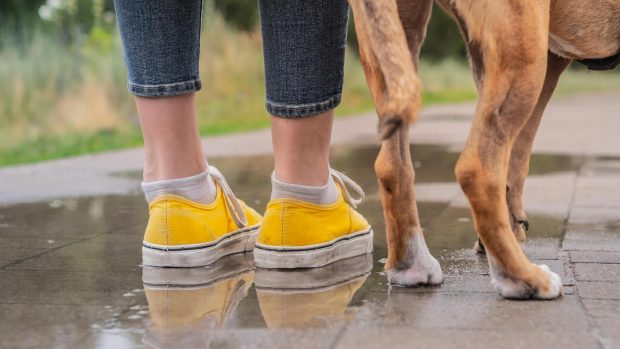There are a number of reasons as to why a dog might jump up at you and they don’t all require the same response. Sometimes it’s obvious – if you’re holding a stick in the air and your dog really wants the stick, he might jump up to get it. But not all dogs jump up due to lack of impulse control. Sometimes your dog is trying to tell you something.
In general, it’s not a good idea to allow your dog to jump up at you so it’s important to understand why it’s happening but also know how to stop a dog jumping up and when it’s appropriate to do this.
Why do dogs jump up at you?
1. They’re excited
Most puppies that are bold and sociable can’t quite contain their excitement when meeting people, both new and familiar. The same can be said for most people meeting a cute puppy. We’re all guilty of mushing over them – we stop speaking normally and start squeaking incoherently in an over-excited tone. This adds more excitement to the moment and the way a puppy releases that energy is to jump up. This is not a naughty or aggressive dog, but a young dog with no impulse control over their emotions and no direction from their owner.
2. They’re figuring out the hierarchy
When it comes to dogs, there is no such thing as dominance or a pack leader, instead it is based on respect. It can be an age thing or it can be a personality trait. Not every animal is born to lead, some are quite relaxed without getting into pack politics – these dogs tend to be more the submissive type. My last Irish Terrier, Doris, ruled my mastiffs with an iron fist, despite being a fraction of their size and weight.
Dogs learn about the hierarchy as puppies. Older dogs tell off over-exuberant puppies when they overstep the mark and have either invaded the older dog’s personal space or have not stopped playing and biting when the older dog has signalled they’ve had enough.
If you watch dogs interact, you will see that if a dog can move another dog, it’s above it in the group. If your dog is jumping up at you in an attempt to move you around, he’s either testing the waters or believes that he’s above you in the hierarchy.
3. They’re seeking your attention
Jumping up is also a form of attention seeking. It is usually followed by more jumping up when you stop the stroking and fuss that has been demanded.
4. They’re frustrated
If your dog is jumping up at you while out walking on the lead, this can be a sign of frustration that your dog unable to let off steam or is pushing the boundaries within the relationship. Here are some tips on how to stop dogs pulling on the lead that might help.
5. They’re seeking reassurance
If a dog jumps up at the side of you or at your back (standing on their hindlegs and placing their feet on your legs), they are seeking height and asking for reassurance. They are trying to communicate to you that they are feeling afraid, vulnerable and insecure, so they need you to reassure them rather than scold them. While it can be irritating, especially in wet weather, this is the only way your dog can tell you how they are feeling other than vocalising fearfully.
I definitely cannot lift Neville, one of my mastiffs, to a place of height when he’s anxious, but I can reassure him and put him behind me so that he knows I will deal with whatever it is that has scared him. Last time it was the local pub cat hissing at him – he then farted, bumped his head on the table and ran behind me. So, you see, not every form of jumping up is bad behaviour and it is your duty to make your dog feel safe and control their environment so they do not feel exposed and vulnerable.
6. You’ve unintentionally taught them to do it
This is a very common mistake that everyone makes with a puppy. It jumps to greet you, so you feel like you’re special, and it’s so cute and so on and so forth. Every time the puppy jumps you respond to it with words or touch, in effect, affirming the behaviour. You’ve inadvertently trained the dog that this is what you want it to do because every time it does it, it gets attention, fuss and is not corrected.
The dog then gets older and it’s not so cute anymore when he’s knocking you off balance, covering you in mud, or is doing the same thing to other people that you may or may not know. This is not the dog’s fault; this is what you have trained it to do, albeit unconsciously, by not addressing the behaviour or correcting it when the dog was young.
Sometimes, it can be others that have taught the behaviour – again, without intending to do so. When I first got Gladys, another one of my mastiffs, she was a nightmare for jumping up – and she still has moments now – but it is not for my lack of correcting and teaching her “off”. The problem arises when other people immediately and stroke her when she jumps up and say “It’s ok, I don’t mind” – well I do! These people are training my dog by rewarding her with touch and attention, teaching her that this is an acceptable way to greet people, which it is not.
7. They’ve been taught to do it as a trick
Just like teaching your dog to lie down, some owners teach their dogs to jump up for treats or toys. This can be a problem if your dog starts to jump up of their own accord and expects a reward for doing so.
You might also like:

7 reasons that a dog might jump up at you

Why does my dog shake?

Why does my dog eat poop?

How to master loose lead walking

Why does my dog stare at me? An expert explains

How to master recall

Subscribe to Horse & Hound magazine today – and enjoy unlimited website access all year round
Horse & Hound magazine, out every Thursday, is packed with all the latest news and reports, as well as interviews, specials, nostalgia, vet and training advice. Find how you can enjoy the magazine delivered to your door every week, plus options to upgrade your subscription to access our online service that brings you breaking news and reports as well as other benefits.



